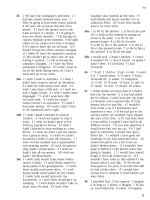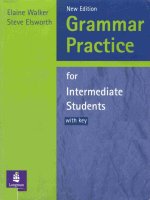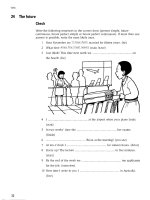Tài liệu Longman English Grammar Practice for intermediate students docx
Bạn đang xem bản rút gọn của tài liệu. Xem và tải ngay bản đầy đủ của tài liệu tại đây (600.9 KB, 15 trang )
L O N G M A N
E N GLIS H
GRAMMAR
PRAC T IC E
for
intermediate
students
L.
G.
Alexander
For more material and information, please visit www.tailieuduhoc.org
ur
h
G
2
0
Addison Wesley Longman Limited
Edinb ate,
Harlow,
Essex
8
~
ZJE,
England
and
Associated
Companies
throughout
the
world.
0
Longman Group UK Limited 1990
All
rights
reserved;
no
part
of
this
publication
may
be
reproduced,
stored
in
a
retrieval
system,
or
transmitted
in
any
form
or
by
any
means,
electronic,
mechanical,
photocopying,
recording,
or
otherwise,
without
the
prior
written
permission
of
the
Publjshers.
Distributed in the United States of American by
Addison Wesley Longman, New York
First published 1990
Eleventh impression 1998
Cartoons by Larry, Ed Mclaughlin and David Simonds
Br it is h Library Cataloguing i n Pu blica tion Data
Alexander, L. G. (Louis George) 1932-
Longman English grammar practice (Intermediate level)
1.
English language. Grammar
I. Title
428.2
Library of Congress Cata lo ging
-
in
-
Pu bl ica tion Data
Alexander, L. G.
Longman English gmmmar practice (Intermed~atelevel)
1
L G Alexander.
p. cm.
1.
English language
-
Textbooks for fore~gnspeakers
2. Engl~shlanguage
-
Grammar
-
1950
-
Problems,
exercises,
etc
i
T~tle
PEll28.A4573 1990
428.2'4
-
&20 89-13851
CIP
Set in 9111.5 pt. Linotron Helvetica Roman
Produced through Longman Malaysia, ACM
ISBN 0 582 04500 2
For more material and information, please visit www.tailieuduhoc.org
Contents
To
the
student
The
sentence
Sentence
word
order
The
simple
sentence:
verbs
with
and
without
objects
The
simple
sentence:
direct
and
indirect
objects
The
compound
sentence
The
complex
sentence:
noun
clauses
The
complex
sentence:
relative
pronouns
and
clauses
The
complex
sentence:
'whose';
defininglnon
-
defining
clauses
The
complex
sentence:
time,
place,
manner
The
complex
sentence:
reason
and
contrast
The
complex
sentence:
purpose,
result
and
comparison
The
complex
sentence:
present
participle
constructions
The
complex
sentence:
perfectlpast
participle
constructions
Nouns
One
-
word
nouns
Compound
nouns
Countable
and
uncountable
nouns
( I )
Countable
and
uncountable
nouns
(2)
Number
(singular
and
plural)
(1)
Number
(singular
and
plural)
(2)
Gender
The
genitive
Articles
7
-
The
indefinite
article:
'dan'
(1)
The
indefinite
article:
Wan'
(2)
The
definite
article:
'the'
(1)
The
definite
article:
'the'
(2)
The
zero
article
(1
)
The
zero
article
(2)
Pronouns
Personal
pronouns
'One'
'It'
and
'onelsomelanylnone'
Possessive
adjectives
and
possessive
pronouns
('mylmine')
Reflexive
pronouns
('myself')
Demonstrative
adjslprons
('this');
'somelanylno'
compounds
('someone')
Quantity
Quantifiers
+
countable
and
uncountable
nouns
General
and
specific
references
to
quantity
Uses
of
'some',
'any',
'no'
and
'none'
'Much',
'many',
'a
lot
of',
'(a)
few',
'(a)
little',
'fewer',
'less'
'Both'
and
'all'
'All
(the)',
'(dthe)
whole',
'each'
and
'every'
'Another',
'(the)
other(s)',
'either',
'neither',
'each
(one
of)'
For more material and information, please visit www.tailieuduhoc.org
Contents
Adjectives
Formation
of
adjectives
Position
of
adjectives
Adjectives
that
behave
like
nouns;
'-edl-ing'
endings
Adjectives
after
'be',
'seem',
etc.;
word
order
of
adjectives
The
comparison
of
adjectives
Adverbs
Adverbs
of
manner
Adverbs
of
time
Adverbial
phrases
of
duration
Adverbs
of
frequency
Adverbs
of
degree
Intensifiers
Focus
adverbs
Viewpoint
adverbs,
connecting
adverbs
and
inversion
Prepositions,
adverb
particles
and
phrasal
verbs
Prepositions,
adverb
particles
and
conjunctions
Prepositions
of
movement
and
position;
prepositions
of
time
Particular
prepositions,
particles:
contrasts
(1
)
Particular
prepositions,
particles:
contrasts
(2)
Particular
prepositions,
particles:
contrasts
(3)
Phrasal
verbs:
Type
1,
verb
+
preposition
(transitive)
Phrasal
verbs:
Type
2,
verb
+
particle
(transitive)
Phrasal
verbs:
Type
3,
verb
+
particle
(intransitive)
Type
4,
verb
+
particle
+
preposition
(transitive)
Verbs,
verb
tenses,
imperatives
The
simple
present
and
present
progressive
tenses
(1)
The
simple
present
and
present
progressive
tenses
(2)
The
simple
past
tense
The
simple
past
and
past
progressive
tenses
The
simple
present
perfect
and
present
perfect
progressive
The
simple
past
perfect
and
past
perfect
progressive
tenses
The
simple
future
tense
The
simple
future,
the
future
progressive,
the
future
perfect
'Going
to'
and
other
ways
of
expressing
the
future
The
imperative
Be,
Have,
Do
'Be'
as
a
full
verb
(1)
'Be'
as
a
full
verb
(2)
'There'
+
'be'
Verbs
related
in
meaning
to
'be'
'Have'
as
a
full
verb
=
'possess';
'have
got'
=
'possess'
'Have'
as
a
full
verb
meaning
'eat',
'enjoy',
etc.
'Do'
as
a
full
verb
Modal
auxiliaries
and
related
verbs
The
two
uses
of
modal
verbs
Uses
of
modals
(etc.)
to
express
ability
and
inability
Uses
of
modals
(etc.)
to
express
permission
and
prohibition
For more material and information, please visit www.tailieuduhoc.org
Contents
11.4
Uses
of
modals
(etc.)
to
express
certainty
and
possibility
11.5
Uses
of
modals
to
express
deduction
11.6
Uses
of
modals
for
offers,
requests
and
suggestions
11.7
Expressing
wishes,
etc.:
'I
wish',
'if
only',
'it's
(high)
time'
11.8
Expressing
preferences:
'would
rather'
and
'would
sooner'
11.9
'It's
advisable
'
l'lt's
necessary
'
11.10
'It
isn't
advisable
'
/'It
isn't
necessary
'
/'It's
forbidden'
11
. I
1
Modals
to
express
habit:
'used
to',
'will'
and
'would'
11.12
'Need'
and
'dare'
as
modals
and
as
full
verbs
11.13
'Wouldlwouldn't';
'that
should';
'there'
+
modal
The
passive
and
the
causative
General
information
about
form
Uses
of
the
passive
Form
and
use
of
the
causative
Questions,
answers,
negatives
YesINo
questions,
negative
statements,
YesINo
answers
Alternative
negative
forms
and
negative
questions
Tag
questions
and
echo
tags
Additions
and
responses
Question
-
word
questions
(1):
'Who(m)
?',
'What
?'
Question
-
word
questions
(2):
'When?',
'Where?',
'Which?',
'Whose?'
Question
-
word
questions
(3):
'Why?',
'How?'
Subject
-
questions:
'Who?',
'What?',
'Which?',
'Whose?'
Questions
about
alternatives;
emphatic
questions
with
'ever'
Conditional
sentences
Type
1
conditionals
-
Type
2
conditionals
'
Type
3
conditionals
Mixed
conditionals;
'unlesslif
not',
etc.
Direct
and
indirect
speech
Direct
speech
'Say',
'tell'
and
'ask'
lndirect
statements
with
tense
changes
Indirect
questions
with
tense
changes
Uses
of
the
to
-
infinitive
in
indirect
speech
When
we
use
indirect
speech
The
infinitive
and
the
'-ing'
form
The
bare
infinitive
and
the
toinfinitive
The
bare
infinitive
or
the
'-ing'
form;
the
toinfinitive
Verb
(+
nounlpronoun)
+
toinfinitive
Adjectives
and
nouns
+
toinfinitive
The
'-ing'
form
Verb
+
the
'-ing'
form
Adjectives,
nouns
and
prepositions
+
'
-
ing'
The
toinfinitive
or
the
'-ing'
form?
Index
Key
For more material and information, please visit www.tailieuduhoc.org
For more material and information, please visit www.tailieuduhoc.org
Acknowledgements
Different
versions
of
these
materials
were
tried
out
with
students
in
five
countries.
The
book
is
in
its present
form
partly
as
a
result
of
the
useful
reports
and
in
many
cases
the
very
detailed
comments received
while
the
work
was
being
developed.
I
would
like
to
thank
the
following:
Brazil
Germany
Greece
Italy
United
Kingdom
Vera
Regina
de
A
Couto
and
staff
Cultura
Inglesa,
Rio
Rosa
Lenzuen
Louise
Towersey
Michael
Watkins
Cultura
Inglesa,
Curitiba
Werner
Kieweg University
of
Munich
Norman
Lewis
,
Gymnasium
Wildeshausen
Robert
Nowacek
Volkshochschule,
Kaufbeuren
Sandra
Klapsis
Homer
Association,
Athens
Joanna
Malliou
George
Rigas The
Morai'tis
School,
Athens
Paola
Giovamma
Ottolino Liceo
Linguistico,
A.
Manzoni,
Milano
Sue
Boardman Bell
School,
Saffron
Walden
Pat
Lodge
Alan
Fortune Ealing
cdllege
of
Higher
Education
Mary
Stephens Eurocentre,
Bournemouth
M.
Milmo Eurocentre,
Lee
Green
Steve
Moore
Jennifer
Swift
Ann
Timson
Josephine
von
Waskowski
I
would
also
like
to
thank:
-
Donald
Adamson
and
Neville
Grant
for
their
detailed
and
stimulating
commentaries
and
particularly
Roy
Kingsbury
for
his
comprehensive
report
and
notes
on
exercise
-
types.
-
my
personal
assistant,
Penelope
Parfitt,
and
my
wife,
Julia,
for
reading
and
commenting
on
the
work
at
every
stage
of
its
development.
I
am
especially
grateful
to
my
publishers
and
their
representatives
for
administering
and
monitoring
the
trialling
of
the
manuscript
in
various
locations
round
the
world
and
for
exercising
such
care
and
skill
to
1
see
the
work
through
to
publication.
To
the
student
Why do we learn grammar?
There
is
no
point
in
learning
grammar
for
the
sake
of
learning
grammar.
Grammar
is
the
support
system
of
communication
and
we
learn
it
to
communicate
better.
Grammar
explains
the
why
and
how
of
language.
We
learn
it
because
we
just
can't
do
without
it.
Who is this book for and what does it cover?
This
book
deals
entirely
with
English
as
a
foreign
language
(EFL).
It
is
for
intermediate
students
who
are
working
with
a
teacher
or
working
on
their
own.
It
covers
every
important
area
of
the
English
language.
If
you
look
at
the
Contents
pages,
you
will
find
sixteen
major
areas
which
form
the
basis
of
English
grammar.
This
book
is
based
on
the
Longman
English
Grammar
and
the
grammatical
information
in
it
is
all
drawn
from
this
work.
Longman
English
Grammar
Practice
has
been
designed
to
stand
on
its
own.
Students
who
require
further
grammatical
information
can
refer
to
the
Longman
English
Grammar.
How the material is organized
Longman
English
Grammar
Practice
is
a
practice
book.
It
is
intended
to
support
(not
replace)
the
material
in
language
courses
and
is
organized
for
this
purpose:
The
material
is
laid
out
on
facing
pages.
Each
set
of
facing
pages
deals
with
a
major
point
of
grammar.
This
major
point
is
divided
into
small,
manageable
amounts
of
information.
Clear
notes
explain
the
points
to
be
practised,
followed
by
an
exercise
on
just
those
points.
The
last
exercise
is
in
context,
usually
an
entertaining
story
with
a
cartoon
illustration.
It
sums
up
all
you
have
learnt
in
the
exercises
you
have
just
done
and
shows
you
how
the
language
works.
It
is
a
'reward'
for
the
hard
work
you
have
just
been
doing!
"
.
Cross references
If
you
see
e.g.
[>
7.3A]
in
the
notes,
it
means
that
a
similar
point
is
discussed
in
some
other
part
of
the
book.
Follow
up
the
reference
for
parallel
practice
or
information
if
you
want
to.
If
you
see
e.g.
[>
LEG
4.301
at
the
top
of
the
notes,
it
means
that
the
point
is
dealt
with
in
the
Longman
English
Grammar.
Follow
up
the
reference
if
you
want
'the
whole
story'.
How to work
YOU
DON'T
HAVE
TO
WORK
THROUGH
THIS
BOOK
FROM
START
TO
FINISH!
It
is
not
arranged
in
order
of
increasing
difficulty.
Select
a
chapter
or
part
of
a
chapter
which
you
want
to
study.
Do
this
by
referring
to
the
Contents
pages
or
the
Index.
Usually,
this
will
be
a
topic
you
have
been
dealing
with
in
your
language
course.
Then:
1
Read
the
notes
carefully
(called
Study).
Notes
and
exercises
are
marked
like
this:
=
Elementary
I**I
=
Intermediate
(most
exercises)
I***I
=
Advanced
You
will
sometimes
find
that
you
know
some,
but
not
all,
of
the
points
in
an
exercise
marked
El.
2
Do
the
exercises
(called
Write).
Always
leave
the
story
till
last
(called
Context).
3
Check
your
answers
with
your
teacher.
4
If
you
have
made
mistakes,
study
the
notes
again
until
you
have
understood
where
you
went
wrong
and
why.
1
The
sentence
1.1
Sentence
word
order
1.1
A
The
basic
word
order
of
an
English
sentence
[>
LE
G
I
.3]
Study:
The
meaning
of
an
English
sentence
depends
on
the
word
order.
1
We
put
the
subject
before
the
verb
and
the
object
after
the
verb:
The
cook
I
burnt
I
the
dinner.
2
Adverbials
(How?,
Where?,
When?)
usually
come
after
the
verb
or
after
the
object:
He
read
the
note
quickly.
(How?)I
waited
at
the
corner
(Where
?)
till
11.30.
(When?)
3
The
basic
word
order
of
a
sentence
that
is
not
a
question
or
a
command
is
usually:
subject verb object adverbials
How? Where?
When?
I bought a
hat yesterday.
The
children
have
gone home.
We ate our
meal
in
silence.
Write
1:
a
Rewrite
the
sentences
that
don't
make
sense.
b
Mark
all
the
sentences
in
the
exercise
S
V
0
to
show
Subject,
Verb,
Object.
Has
set
John
Bailey
a
new
high
-
jump
record.
I
S
I
J
%
.
@
~
.
~
~
h
a
d
.
&
.
I
8
R
a
a
w
.
~
-
~
The
passport
examined
the
passport
officer.
These
biscuits
don't
like
the
dogs.
The
shop
assistant
is
wrapping
the
parcel.
Have
seen
the
visitors
the
new
buildings.
My
father
didn't
wash
the
dishes.
The
pipe
is
going
to
fix
the
plumber.
Will
the
goalkeeper
catch
the
ball?
Has
the
meal
enjoyed
the
guest?
Can't
play
John
the
game.
Write
2:
a
Arrange
these
words
in
the
right
order.
Use
a
capital
letter
to
begin
each
sentence.
b
Mark
each
rewritten
sentence
S
V
0
M
P
T
to
show:
Subject,
Verb,
Object,
Manner
(How?),
Place
(Where?),
Time
(When?).
till
11
o'clock
this
morning
I
slept
I
the
c h i l d r e n ( s R . & . * . . ~ v I ~ . ~ ~ . ~ . ! ! . ~ ' ~ . ~ . . ~
the
papers
I
into
the
bin
I
he
threw
I
don't
speak
I
well
I
English
hides
I
Mrs
Jones
I
her
money
I
under
the
bed
carefully
I
this
suitcase
I
you
didn't
pack
on
this
shelf
I
I
left
I
this
morning
I
some
money
from
the
bank
I
a
loan
I
you'll
have
to
get
the
phone
I
in
the
middle
of
the
night
I
woke
me
up
in
the
park
I
you
shouldn't
walk
I
at
night
your
food
I
you
should
sat
I
slow:y
my
term
I
begins
I
in
October
your
article
1
I
I
quickly
1
last
night
I
in
bed
/
read
4
my
umbrella
I
where
did
you
put
(
1
5
arrived
I
the
train
I
fifteen
minutes
late
(
1
1.1
Sentence word order
The
forms
of
a
sentence
[>
L
E
G
I
.2]
Study:
I**
I
Write:
1
A
sentence
can
take
any
one
of
four
forms:
-
a
statement:
The
shops
close/donltclose
at
7
tonight.
-
a
question:
Do
the
shops
close
at
7
tonight?
-
a
command:
Shut
the
door./Donltshut
the
door.
-
an
exclamation:
What
a
slow
train
this
is!
2
When
we
write
a
sentence,
we
must
begin
with
a
capital
letter
and
end
with
a
full
stop
(.),
a
question
mark
(?),
or
an
exclamation
mark
(!).
a
Arrange
these
groups
of
words
in
the
right
order.
Add
(.),
(?)
or
(!).
b
Describe
each
sentence
as
a
statement,
question,
command
or
exclamation:
S,
Q,
C
or
E.
1
the
coffee
I
don't
spill
Dd# & Wf%%:
(
c
)
2
today's
papers
I
have
you
seen
(
1
3
to
meet
you
1
how
nice
(
1
6
on
time
(
the
plane
(
won't
arrive
(
1
7
this
electricity
bill
1
I
can't
pay
(
1
8
for
me
1
please
I
open
the
door
(
1
9
the
nearest
hotel
I
where's
I
he
asked
(
1
10
the
bill
I
can't
pay
I
I
1
he
cried
(
1
1.1C
Context
' ' X
.
e
a
.
Write:
R
e
n
c
e
i
n
t
h
e
r
i
g
h
t
o
r
d
e
r
.
A
d
d
c
a
p
i
t
a
l
l
e
t
t
e
r
s
a
n
d
(
,
)
,
A
1
2
3
4
5
6
7
I
I
have
lived
here'
.
8
'isn't
it
I
it's
a
quiet
sort
of
place'
9
'here
I
a
quiet
life
I
we
live
10
a
cinema
I
we
don't
have
I
or
a
theatre
1 1
our
school
I
five
years
ago
I
was
closed
12
only
one
shop
/
we
have
13
calls
I
a
bus
I
once
a
day
14
here
I
in
55
B.C.
I
came
I
the
Romans
15
since
then
I
has
happened
I
nothing'
Thank you for trying Solid Converter PDF Professional.
The trial version of this product only converts 10% of your document, with a 10 page maximum.
For this conversion, Solid Converter PDF Professional converted 10 of 302 pages.
Please purchase Solid Converter PDF Professional at to
remove this restriction.









